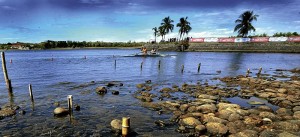Legendary Paoay Lake comes alive

ONCE teeming with fish cages and faced with a pollution problem, Paoay Lake in Ilocos Norte is now a water sports venue attracting local and foreign athletes. AUGUST DELA CRUZ
Unknown to many, the serene Paoay Lake, known for its legendary past, had been blighted by wastes coming from fish cages resulting in high E. coli bacteria contamination for years.
The 387-hectare lake in Paoay, Ilocos Norte, had been largely used for raising fish in cages for decades. Surrounding communities also used it as dumping ground for wastes from backyard poultry and piggery farms. And it is where the local water district draws its raw water source for consumers’ tap water.
Alarmed by the increasing number of fish cages, the Ilocos Norte Water District (Inwad) started collecting water samples in July 2011 in five communities—the villages of Nangguyudan, Nangguyudan Centro, Sungadan, Suba and Nagbacalan.
Test results confirmed the presence of E. coli, ranging from 2,840 hpc (heterotrophic plate count) in one sampling point to 5,780 hpc in another point—way above the normal level of 500 hpc.
The areas with the highest bacteria concentration were noted in Sungadan (5,680 hpc) and Nagbacalan (5,780 hpc), where most fish cages are found.
Article continues after this advertisementJinky Calapit, Inwad medical technologist, said water taken from the lake undergoes several treatment processes—from microfiltration to chlorination—before this is fed as tap water to consumers.
Article continues after this advertisement“Lake water becomes free of any contaminants once it undergoes treatment. We make sure that water is safe for human consumption,” she said.
She said the Paoay Lake has always been positive for E. coli bacteria, which become even higher during the rainy season.
“Even our deep wells are contaminated with E. coli, how much more with raw water [from Paoay Lake] which does not undergo any kind of water treatment. Without chlorine treatment, water from deep wells will not be free of bacteria,” Calapit said.
Challenge
Getting rid of the fish cages has always been a challenge for the provincial government until the holding of the 71st International Regatta with the Paoay Lake as venue for international rowing competition last month.
On top of organizing the global water sports, Gov. Imee Marcos made sure that the lake would be free from debris of all kinds before the event began on Jan. 13.
Marcos announced that the villages ringing the lake had kept the lake free from fish cages. “We pulled out the last fish cages which had been causing the pollution,” she said during the inaugural launch of the weeklong sports competition.
Water sampling conducted in January after the cages were removed showed a diminished contamination level. “We are proud to declare that Paoay Lake is pollution-free. No other place can offer this,” Marcos said.
The lake became the playground of international rowers belonging to the Amateur Rowing Association of the East-Far East Amateur Rowing Association (Ara-Feara).
Amateur rowers from India, Hong Kong, United Arab Emirates, Pakistan, Singapore, Malaysia, Sri Lanka, the United Kingdom, New Zealand and host Philippines took part in the lake sports and, in the process, launched the lake as an international rowing center.
James Straton of the Manila Boat Club, which is behind the competition, said the lake carries a potential to become the training ground for Olympic teams.
“We hope to see more global water sports here so that Ilocos Norte will be known as the province that started rowing in the Philippines,” he said.